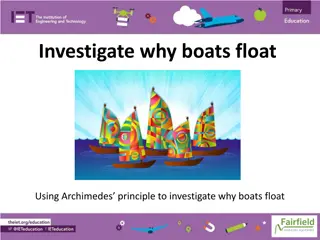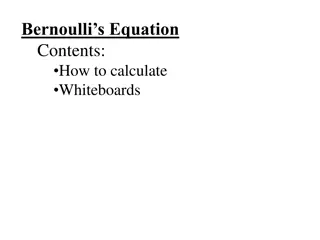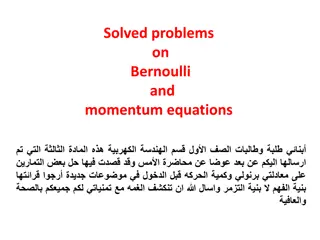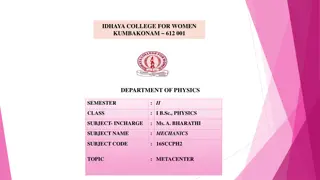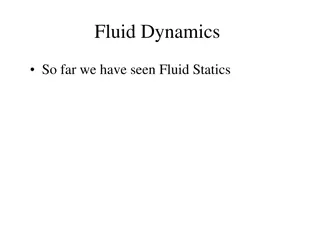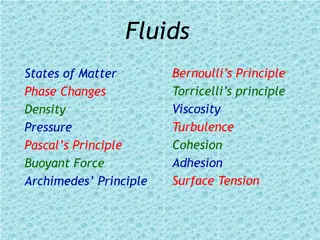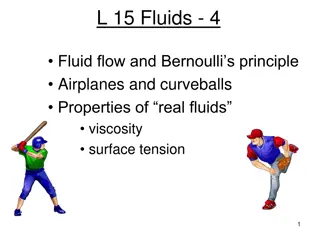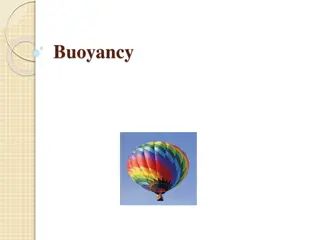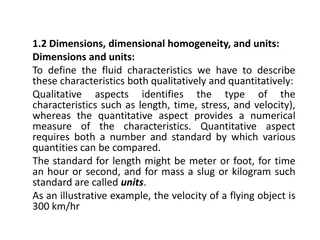Understanding Fluid Mechanics: Archimedes, Pascal, and Bernoulli
Explore the principles of fluid mechanics including Archimedes' Principle, Pascal's Law, and Bernoulli's Principle. Learn about mass density, buoyant force, and the behavior of floating objects in liquids. Discover how the buoyant force is equal to the weight of displaced fluids, and how it affects objects submerged in liquids. Dive into the fascinating world of fluids and their interaction with various forces.
Download Presentation

Please find below an Image/Link to download the presentation.
The content on the website is provided AS IS for your information and personal use only. It may not be sold, licensed, or shared on other websites without obtaining consent from the author. Download presentation by click this link. If you encounter any issues during the download, it is possible that the publisher has removed the file from their server.
E N D
Presentation Transcript
Fluids: Archimedes Principle, Pascals Law, Bernoullis Principle
Fluids and Buoyant Force Fluids: Matter that flows (liquid and gas). Mass Density: Mass per unit volume of a substance. It is often represented by the Greek letter (rho). = m o o v Buoyant Force: The upward force on objects that are partially or completely submerged in fluids. o
Archimedes Principle
Any object completely or partially submerged in a fluid experiences an upward force equal in magnitude to the weight of the fluid displaced by the object. - Archimedes Principle
For Floating Objects Buoyant Force: FB= Fg (displaced)= mf g where mf= mass of fluid displaced For Floating Objects: FB= Fg (object)= mog
Image source: 2008 Yupi666, Wikimedia Commons http://commons.wikimedia.org/wiki/File:Buoyancy.svg
Archimedes Principle: The buoyant force is equal to the weight of the displaced water. Image source: Bradley W. Carroll. Used with permission. http://physics.weber.edu/carroll/archimedes/principle.htm
ball: displaced water weighs less than the ball hull: displaced water weight equals hull weight Image source: Bradley W. Carroll. Used with permission. http://physics.weber.edu/carroll/archimedes/principle.htm
Buoyant Force Buoyant force is also equal to the difference between the weight of an object in air and weight of an object in fluid. FB= Wair- Wfluid In other words, the apparent loss in weight of a body immersed in a fluid is equal to the weight of the displaced fluid.
Other Relationships Net force (Fnet) is the object s apparent weight: Fnet= FB Fg (object) Fnet= ( fvf- ovo) g where: m = v In solving buoyancy problems, the following derived expression is used: = 0 f Fg (object) FB
Pascals Law
Pressure Pressure is a measure of how much force is applied over a given area. P = F A units: 1 Pa (Pascal) = 1 N/m2 1 atm = 105 Pa
Pressure applied to a fluid in a closed container is transmitted equally to every point of the fluid and to the walls of the container. - Pascal s Law
o Pressure applied anywhere to a fluid causes a force to be transmitted equally in all directions. o Change in pressure disperses equally throughout the fluid. o Force acts at right angles to any surface in contact with the fluid. A1= 1 m2 F1= 10 N P1= ___? A2= 10 m2 P2= ____? F2= ____? Image source: Bill Winfield. Used with permission.
Bernoullis Principle
Types of Fluid Flow o Laminar: When fluid particles move along the same smooth path. The path is called a streamline. Source: Wikimedia Commons http://commons.wikimedia.org/wiki/File:Toky.png
Types of Fluid Flow o Turbulent: When fluid particles flow irregularly causing changes in velocity. They form eddy currents. Source: Wikimedia Commons http://commons.wikimedia.org/wiki/File:Toky.png
The pressure in a fluid decreases as the fluid s velocity increases. - Bernoulli s Principle Continuity equation: A1v1= A2v2 Bernoulli s equation: P + v2+ gh = constant
Bernoullis equation at different points in a horizontal pipe: P1+ v12= P2+ v22 Point 3 Point 1 Point 2 Image source: 2013 Emily Sappington, University of Houston
Bernoullis Equation Source: NASA http://www.grc.nasa.gov/WWW/k-12/airplane/bern.html
Bernoullis equation at two different points of varying height P1+ v12+ gh1= P2+ v22+ gh2 Source: http://commons.wikimedia.org/wiki/File:BernoullisLawDerivationDiagram.svg


